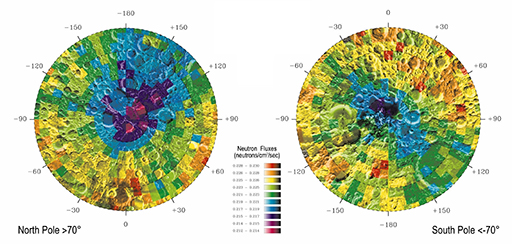2.4 Results from the Lunar Prospector mission
As with Clementine, initial findings were very encouraging; the greatest concentrations of hydrogen were seen in craters near the lunar poles, and these were taken to be in the form of water-ice, equivalent to almost 300 million metric tonnes in mass.
Figure 10 shows the neutron spectrometer results from the Lunar Prospector mission. Where fewer neutrons are measured, this indicates the presence of greater concentrations of hydrogen in that area. Areas shaded blue and purple are places where the spacecraft observed the lowest neutron counts and thus have high hydrogen abundances.
The final stage of the mission involved crashing Lunar Prospector into the Moon, in order to generate a plume of ejected material. It was hoped that any water present in this plume kicked up by the spacecraft would be detected by instruments in observatories back on Earth. However, although the crash into a polar crater went according to plan, no plume was observed at all, let alone any water-ice within it.
So, although these measurements of hydrogen matched the locations for the potential water found by Clementine, nobody had yet directly observed genuine H2O on the surface of the Moon.

